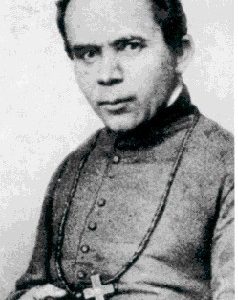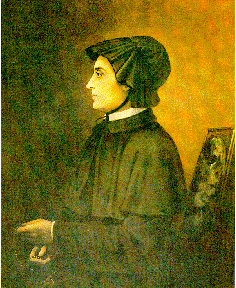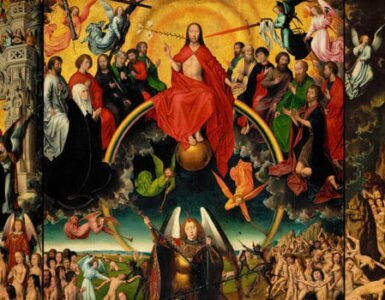Jesus’ teaching about the ‘narrow door’ to salvation
is commonly cited in support of the view that many will be damned and against hoping
that all might be saved.
Except Jesus does not say as much as many think. The
teaching appears in both Matthew and Luke. Below are both sections as they
appear in the revised edition of the New American Bible:
“Enter through the narrow gate; for the gate is wide and the road broad that leads to destruction, and those who enter through it are many. How narrow the gate and constricted the road that leads to life. And those who find it are few.”
Matthew 7:13-14
Someone asked him, “Lord, will only a few people be saved?” He answered them,“Strive to enter through the narrow door, for many, I tell you, will attempt to enter but will not be strong enough. After the master of the house has arisen and locked the door, then will you stand outside knocking and saying, ‘Lord, open the door for us.’ He will say to you in reply, ‘I do not know where you are from.’ And you will say, ‘We ate and drank in your company and you taught in our streets.’ Then he will say to you, ‘I do not know where you are from. Depart from me, all you evildoers!’ And there will be wailing and grinding of teeth when you see Abraham, Isaac, and Jacob and all the prophets in the kingdom of God and you yourselves cast out. And people will come from the east and the west and from the north and the south and will recline at table in the kingdom of God. For behold, some are last who will be first, and some are first who will be last.”
Luke 13:23-30
Let’s take Matthew first. At first blush, the two
verses seem, quite literally, damning. The second verse seems to support the
interpretation that the narrow gate means there will be a small number of
people who make it to heaven. Just one problem: that’s not how most
commentators interpret the narrow gate. The general view instead seems to be
that the narrowness of the gate refers not to the numbers getting in but to the
narrowness, or singularity of the way in.
Here, for example, is Pope St. John Paul in an address
in 1993 to lay representatives of Jamaica:
Reject the easy road: the road of self–indulgence, crime, cynicism and escape from responsibility. The abuse of alcohol and drugs and sexual misbehaviour must have no place in your lives. “Enter by the narrow gate” (Mt. 7: 13). Choose the road that leads to eternal life and happiness with God. … In all things let the words of Jesus live in you, and you will know the joy that comes from belonging to him.
An ancient gloss cited by St. Thomas Aquinas in the Aurea Catena says something similar:
Though love be wide, yet it leads men from the earth through difficult and steep ways. It is sufficiently difficult to cast aside all other things, and to love One only, not to aim at prosperity, not to fear adversity.
Another ancient commentator cited by Aquinas
elaborates on the point:
For there are three chief passions in our nature, that are most adhering to the flesh; the desire of food and drink; the love of the man towards the woman; and thirdly, sleep. These it is harder to cut off from the fleshly nature than the other passions. And therefore abstinence from no other passion so sanctifies the body as that a man should be chaste, abstinent, and continuing in watchings. On account therefore of all these righteousnesses, but above all on account of the most toilsome fasting, it is that He says, Enter ye in at the strait gate. The gate of perdition is the Devil, through whom we enter into hell; the gate of life is Christ, through whom we enter into the kingdom of Heaven.
We could say there are many paths to hell—many ways
of mortally sinning—but only one ‘way’ to heaven and one path of sanctity. As
Christ Himself says elsewhere in the gospels, He is the way. However, saying
that the way is narrow doesn’t say anything about how many people get in. The turnstiles to get into a stadium or a
city subway system may be narrow, but that doesn’t mean that the large crowds
waiting outside aren’t getting in. All will eventually.
Of course, in the second verse, Jesus says that only
a few find the narrow gate. Many Church Fathers, St. Augustine and St. Jerome
among them, seem to conclude that many are not saved.
But a closer look at the verse reveals more and
raises additional questions.
One nineteenth century Anglican commentator, Charles Ellicott,
asks what kind of destruction Jesus has in mind. He seems to think it could be
eternal damnation. But, he notes that Jesus hasn’t completely closed the door
to the possibility that those seemingly lost could end up being saved, based on
the parables about the lost sheep and the prodigal son:
“Destruction,” by parity of reasoning, should be more than mere non-existence. On the other hand, the fact of the waste, the loss, the perdition, does not absolutely exclude the possibility of deliverance. The lost sheep was found; the exiled son, perishing with hunger, was brought back to his father’s house.
Second, Ellicott notes that the verbs in Matthew
7:14 are in the present tense: “How narrow the gate and constricted the road
that leads to life. And those who find
it are few.” As Ellicott notes,
If there is any wider hope, it is found in hints and suggestions of the possibilities of the future (1 Peter 3:19; 1 Peter 4:6); in the fact that the words used are emphatically present; in the belief that the short span of this life is not necessarily the whole of the discipline of a soul made for eternity; and that the new life, nascent, and feeble, and stunted here, may be quickened by some new process of education into higher energies.
A third reason for a cautionary reading of Matthew 7
is Luke 13. The significantly longer section in Luke reads as a much longer
elaboration of the two verses in Matthew. The Luke version adds much ambiguity
to the question of how many, if any, will face final damnation.
First, as St. Cyril of Alexandria notes,
Jesus does not directly answer the question about numbers!
Now our Lord does not seem to satisfy him who asked whether there are few that be saved, when He declares the way by which man may become righteous. But it must be observed, that it was our Saviour’s custom to answer those who asked Him, not according as they might judge right, as often as they put to Him useless questions, but with regard to what might be profitable to His hearers. And what advantage would it have been to His hearers to know whether there should be many or few who would be saved. But it was more necessary to know the way by which man may come to salvation. Purposely then He says nothing in answer to the idle question, but turns His discourse to a more important subject.
For St. Cyril, the important question is not ‘How
many?’ but simply ‘How?’
But, for those who insist on finding an answer to
the first question, Jesus’ last two sentences undermine the certainty that the
middle verses seem to offer. Jesus’ vision of a heavenly feast that draws
people from all four corners of the world suggests a scenario in which many are
saved, as commentator John Carroll notes,
The all-encompassing geographical distribution of participants in God’s realm, in company with patriarchs and prophets, provides a second, indirect answer to the question of 13:23, “Are only a few being saved?” Even if the place of the audience is still to be determined by their response to the invitation-with-demand of the present and future realm of God, many from every part of the world will have a place (Luke: A Commentary, 291).
The last sentence adds another degree of ambiguity. “For
behold, some are last who will be first, and some are first who will be last.”
This sounds like all could make it, but not in the same in order. In other
words, there will be saints and then there will be people who spend a lot of
time in purgatory.
In fact another contemporary commentator, François
Bovon, sees the progression of verses as supporting a view that all will be
saved. That’s going too far, since universalism is a condemned heresy. But it
shows just how strongly at odds these last verses are with the view that many
are damned and only a few are saved. Bovon’s concluding words seem a fair
characterization of Luke 13:
This
passage has the dark coloring of threat, but it appears in a context of light.
The human risk of hardening appears against the light background of the gospel
whose door Christ came to open for us, a door that will remain open “as long as
it is called ‘today’” (Heb. 3:13) (Luke
2: A Commentary on the Gospel of Luke 9:51-19:27, 316).
The point is not so much to say that it is wrong to
interpret Matthew 7 as talking about how many will be finally damned. Instead,
it’s only to point out the possibility of an alternative interpretation and to
emphasize that the text is not as conclusive as some people think it is. We
must always be on guard against reading our own biases into Scripture and be
vigilant for the many subtle layers of meaning and connections to other verses
that are always present.












